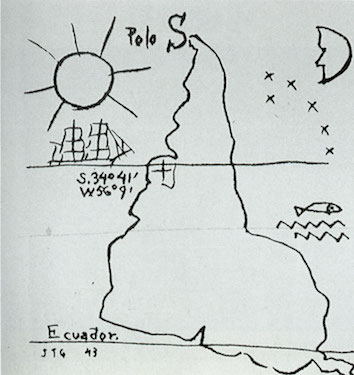The map of Joaquin Torres Garcia saves Patagonia from being the “bottom” of the world, instead making it the gateway from the frozen Antarctic to a verdant and hospitable world. Here, Torres Garcia does more then invert the map, but turns the south into the north. 
“There must not be north for us, except in opposition to our south. Therefore we now turn the map upside down, and then we have a true idea of our position, and not as the rest of the world wishes.”
Of course, “north” here really means “up”. The world map, as we are associated with, creates the illusion that north, always positioned as the uppermost portion of the paper on which it is drawn/printed, resists gravity by resting on the south (this might also serve as a metaphor for other economic realities). In general, this implied gravity exists in any picture plane positioned flat against a wall. (I believe this is not just a consequence of the tradition of treating the picture plane as a window, but might have something to do with human perception.) Regardless of how we are supposed to understand the world map, from above, the physical object that is a map gets pinned to a wall, pinned so that it does not fall on the floor, and we stand in front of this map in order to view it.
Though we can conceptually understand that “north” is not the same as “up”, the uppness of north is felt. Torres Garcia plays with this inherent association, turning the map “upside down” then drawing a boat, floating on top of water. A sun overhead. Up-things.
A globe might be more honest than a map. A map radically distorts the size of countries, as a map is a flattened, rectilinear projection of a sphere. Thus, everything at the “bottom” and “top” of the map is radically enlarged compared to those things near the equator. But a globe, too, is often displayed north-side up.
Furthermore, what an odd thing a globe is. It makes the planet we live on -a ball so large we cannot perceive its curvature with our own senses, on which we are so small as to simply not exist at the distance from which the Earth can be seen in whole- into an object that can be held. An object that can be owned. One’s experience of walking the Earth will never be equatable to the experience of holding a globe. Like a map, it is merely a projection, but the globe invites the type of interaction we see in a scene from Chaplin’s The Great Dictator.
The upness or downess of the map might simply be something unquestioned, a consequence of tradition, and I’m not interested in implying malintent, but I do find it interesting to turn the map over. See how one feels uneasy? It looks like the continents might slide off. One realizes that the proportions of the boundaries of countries are not the means by which we navigate the map. We navigate by recognizing icons. Inverting the map makes it more difficult to locate the United States, yet other countries suddenly begin to exist. Mongolia and Kazakhstan become apparent.
I know nothing about Kazakhstan. The name causes me to assume the culture of the country like a muslim country such as Afghanistan. A quick google search reveals something different from what, to me, the name implied. What language do they speak? What is their national religion? What is their political system? What does their food taste like? They simply do not exist for me. Yet there they are, a country with a territory significantly bigger than that of any European country. People live there every day with lives as real and experiences as potent as mine.
 How we imagine (emphasis put on the image) space implies a meaning. Dante’s construction of Hell places Satan at the center of the Earth, and in the geocentric model of the time, at the center of existence. In christian art, the center of a composition denotes a unique value; the center is a privileged position. There is a dilemma, then. One must resolve the metaphysical incongruity of privileging Satan as the center of all existence, instead of God who exists in the heavens, beyond the dome of the stars.
How we imagine (emphasis put on the image) space implies a meaning. Dante’s construction of Hell places Satan at the center of the Earth, and in the geocentric model of the time, at the center of existence. In christian art, the center of a composition denotes a unique value; the center is a privileged position. There is a dilemma, then. One must resolve the metaphysical incongruity of privileging Satan as the center of all existence, instead of God who exists in the heavens, beyond the dome of the stars.
One can argue this is a sophist’s game, that the revelation of the heliocentric model rendered Dante’s model irrelevant. Of course as far as natural science is concerned, the idea that an unverifiable being sits at the center of the Earth belongs, properly, to the world of fiction. As a system of meaning, however, it is still interesting. When we don’t imagine Dante’s Earth as a globe, but as a flat image, his placing Satan at the bottom and God at the top denotes a moral map. Yet adding another dimension renders his system illogical. Earth has no up or down, and though we divorced ourselves of certain ways of seeing the world, this inherent feeling of upness and downess remains.
